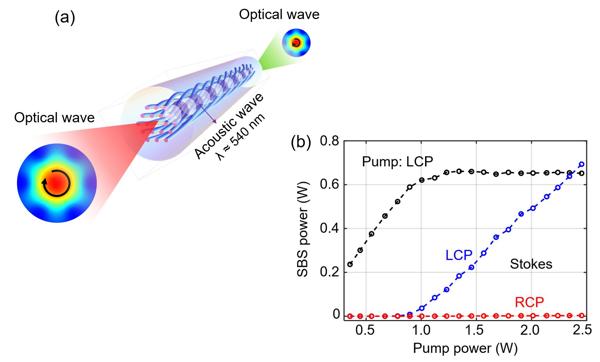The behaviour of light in chiral structures continues to be a subject of great fundamental interest and many applications are emerging in the various subfields of photonics, such as optical activity in biological molecules, lasing in cholesteric liquid crystals, chiral metamaterials, multielement helical structures that act like topological insulators and chiral photonic crystal fibers (PCF).
Amongst them, the chiral photonic crystal fiber − which offers a unique platform for studying the behaviour of light in chiral structures that are infinitely extended in the direction of the twist − has been shown to robustly preserve optical modes carrying circular polarization states and optical vortices over long distances, allowing investigation of nonlinear processes in the presence of chirality.
First observed in bulk materials by Chiao, Townes, and Stoicheff in 1964, stimulated Brillouin scattering (SBS) is a nonlinear optical process in which light is backscattered by a hypersonic acoustic wave. The Doppler-shifted backward signal beats with the pump light, creating a moving interference pattern that in turn amplifies the acoustic wave, leading to strong amplification of the backward signal for high enough pump power.
Since its first demonstration, SBS has been explored and exploited in many different systems, especially optical fibers and integrated photonics. Among the many applications of SBS are narrow linewidth lasers, fiber sensors, light storage systems, and microwave photonic filters. To date, SBS has not yet been studied in chiral-structured waveguides, where the core structure rotates with position along the waveguide axis.
A team of scientists led by Prof. Philip Russell and Dr. Birgit Stiller, at the Max Planck Institute for the Science of Light, Germany, demonstrated for the first time stimulated Brillouin scattering in chiral photonic crystal fibers. The results are published in Photonics Research, Volume 10, No. 3, 2022 (Xinglin Zeng, Wenbin He, Michael H. Frosz, Andreas Geilen, Paul Roth, Gordon K. L. Wong, Philip St.J. Russell, Birgit Stiller. Stimulated Brillouin scattering in chiral photonic crystal fiber[J]. Photonics Research, 2022, 10(3): 03000711).
In the work, the preforms were constructed by the standard stack-and-draw process and the fibers drawn from a spinning preform. The fiber has twisted period of 1.6 cm. The LP01-like core modes have losses of 0.06 dB/m for left-circular polarization (LCP) and 0.05 dB/m right-circular polarization (RCP), birefringence of 2.134 μRIU between LCP and RCP.
Conservation of angular momentum means that the significant Brillouin gain in the chiral PCF is only possible when the Stokes and pump signals have opposite spin order (spin order = +1/−1 is left/right-circular polarization), as shown in Fig. 1. However, in contrast, the polarization states of the Stokes and transmitted pump signals in nonchiral PCF are unpredictable, due to the poor polarization state maintenance ability.

Fig.1. (a) Visualization of light-sound interaction in chiral photonic crystal fiber. Arrows are circular polarization states; (b) Stokes and transmitted pump power in a 38 m length of chiral PCF for LCP pump
A circularly-polarized Brillouin amplifier is demonstrated with this chiral SBS effect, by using 2 m length of chiral PCF. The Brillouin peak gain coefficient is 0.82 m−1W−1 for LCP pump and 0.9 m−1W−1 for RCP pump. The Brillouin absolute gain versus pump power shows gain slope efficiency of 5.67 dB/W.
Next, a circularly-polarized Brillouin laser is demonstrated by placing the 2 m length of chiral PCF in a ring cavity. The laser can stably emit 130 mW continuous-wave (CW) circularly-polarized LP01 mode with Stokes parameter |S3| higher than 0.95. The laser linewidth is measured to be 660 Hz, showing a line-narrowing factor of ∼5×104, Compared with the linewidth of spontaneous Brillouin signal (∼31 MHz).
"This is the first report of SBS in circularly birefringent chiral waveguide. The results open up new opportunities for chiral optoacoustics, with potential applications in quantum optics, fiber sensing, optical tweezers, Brillouin gyroscopes and lasers", says Dr. Xinglin Zeng, who is the first author of this paper. In the future, they will explore light-sound interactions in chiral multicore fibers which can also stably guide optical vortex modes and explore applications such as Brillouin vortex lasers and fiber gyroscopes.


